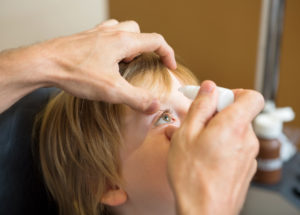March 15, 2022
By Dwight Akerman, OD, MBA, FAAO, FBCLA, FIACLE
 Combining topical low-dose atropine with orthokeratology for controlling axial elongation in juvenile-onset myopia has been studied widely. Five peer-reviewed papers published between 2018 and 2021 suggest that 0.01% atropine combined with orthokeratology effectively slows axial elongation in myopic children.1-5 Furthermore, these papers concluded that axial elongation was significantly slower among participants randomly assigned to the combination treatment than those assigned to OrthoK alone.
Combining topical low-dose atropine with orthokeratology for controlling axial elongation in juvenile-onset myopia has been studied widely. Five peer-reviewed papers published between 2018 and 2021 suggest that 0.01% atropine combined with orthokeratology effectively slows axial elongation in myopic children.1-5 Furthermore, these papers concluded that axial elongation was significantly slower among participants randomly assigned to the combination treatment than those assigned to OrthoK alone.
Through the end of 2021, no study has reported the myopia control effects of combining low-concentration atropine and soft multifocal contact lenses. However, a recently published study by Jones et al. found that the effect of combining 0.01% atropine with soft multifocal contact lenses (SMCL) failed to demonstrate better myopia control than SMCL alone.
The Bifocal & Atropine in Myopia (BAM) study investigated whether combining 0.01% atropine and SMCL with +2.50D add power leads to greater slowing of myopia progression and axial elongation than SMCL alone. Of the total 138 subjects, the mean age was 10.1 ± 1.2 years, and the mean spherical equivalent was -2.28 ± 0.89D. The 3-year adjusted mean myopia progression was -0.52D for Bifocal + Atropine, -0.55D for Bifocal, and -1.09D for Single Vision. The difference in myopia progression was 0.03D (95% CI, -0.14 to 0.21) for Bifocal + Atropine vs Bifocal and 0.57D (95% CI, 0.38-0.77) for Bifocal + Atropine vs Single Vision. The 3-year adjusted axial elongation was 0.31 mm for Bifocal + Atropine, 0.39 mm for Bifocal, and 0.68 mm for Single Vision.
In this 3-year non-randomized clinical study, the researchers concluded that adding 0.01% atropine to SMCL with +2.50D add power failed to demonstrate better myopia control than SMCL alone. The researchers stated that a plausible explanation of why the combination treatment was not better than using a soft multifocal contact lens alone is the relatively low concentration of atropine used in the BAM Study. The Low-Concentration Atropine for Myopia Progression (LAMP) Study suggests that low-concentration atropine slowed myopia progression in a dose-dependent manner, with 0.05% being more effective than 0.01%. The concentration of atropine used in the BAM Study was 0.01%, which might be too weak of a dose to evaluate combination therapy. Another factor that should be considered is compliance for contact lens wear, and atropine use was assessed through self-report in this study. It is possible that the participants/parents may have overestimated their adherence.
Abstract
Effect of Combining 0.01% Atropine with Soft Multifocal Contact Lenses on Myopia Progression in Children
Jenny Huang Jones, Donald Mutti, Lisa A. Jones-Jordan, Jeffrey Walline
Significance: Combining 0.01% atropine with soft multifocal contact lenses (SMCL) failed to demonstrate better myopia control than SMCL alone.
Purpose: The Bifocal & Atropine in Myopia (BAM) study investigated whether combining 0.01% atropine and SMCL with +2.50-D add power leads to greater slowing of myopia progression and axial elongation than SMCL alone.
Methods: BAM participants wore SMCL with +2.50-D add power daily and administered 0.01% atropine eye drops nightly (n = 46). The BAM subjects (Bifocal + Atropine) were age-matched to 46 participants in the Bifocal Lenses In Nearsighted Kids (BLINK) Study who wore SMCL with +2.50-D add (Bifocal) and 46 BLINK participants who wore single vision contact lenses (Single Vision). The primary outcome was the 3-year change in spherical equivalent refractive error determined by cycloplegic autorefraction, and the 3-year change in axial elongation was also evaluated.
Results: Of the total 138 subjects, the mean age was 10.1 ± 1.2 years, and the mean spherical equivalent was -2.28 ± 0.89 D. The 3-year adjusted mean myopia progression was -0.52 D for Bifocal + Atropine, -0.55 D for Bifocal, and -1.09 D for Single Vision. The difference in myopia progression was 0.03 D (95% CI, -0.14 to 0.21) for Bifocal + Atropine vs Bifocal and 0.57 D (95% CI, 0.38-0.77) for Bifocal + Atropine vs Single Vision. The 3-year adjusted axial elongation was 0.31 mm for Bifocal + Atropine, 0.39 mm for Bifocal, and 0.68 mm for Single Vision. The difference in axial elongation was -0.08 mm (95% CI, -0. 16 to 0.002) for Bifocal + Atropine vs Bifocal and -0.37 mm (95% CI, -0.46 to -0.28) for Bifocal + Atropine vs Single Vision.
Conclusions: Adding 0.01% atropine to SMCL with +2.50-D add power failed to demonstrate better myopia control than SMCL alone.
Jones, J. H., Mutti, D. O., Jones-Jordan, L. A., & Walline, J. J. (2022). Effect of Combining 0.01% Atropine with Soft Multifocal Contact Lenses on Myopia Progression in Children. Optometry and Vision Science.
DOI: 10.1097/OPX.0000000000001884
References
- Wan, L., Wei, C. C., Chen, C. S., Chang, C. Y., Lin, C. J., Chen, J. J. Y., … & Lin, H. J. (2018). The synergistic effects of orthokeratology and atropine in slowing the progression of myopia. Journal of clinical medicine, 7(9), 259.
- Kinoshita, N., Konno, Y., Hamada, N., Kanda, Y., Shimmura-Tomita, M., Kaburaki, T., & Kakehashi, A. (2020). Efficacy of combined orthokeratology and 0.01% atropine solution for slowing axial elongation in children with myopia: a 2-year randomised trial. Scientific Reports, 10(1), 1-11.
- Chen, Z., Huang, S., Zhou, J., Xiaomei, Q., Zhou, X., & Xue, F. (2019). Adjunctive effect of orthokeratology and low dose atropine on axial elongation in fast-progressing myopic children—A preliminary retrospective study. Contact Lens and Anterior Eye, 42(4), 439-442.
- Gao, C., Wan, S., Zhang, Y., & Han, J. (2021). The efficacy of atropine combined with orthokeratology in slowing axial elongation of myopia children: a meta-analysis. Eye & Contact Lens, 47(2), 98-103.
- Wang, S., Wang, J., & Wang, N. (2021). Combined orthokeratology with atropine for children with myopia: a meta-analysis. Ophthalmic Research, 64(5), 723-731.













